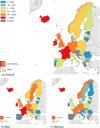The resurgence of syphilis in high-income countries in the 2000s: a focus on Europe
- PMID: 30869043
- PMCID: PMC6518487
- DOI: 10.1017/S0950268819000281
The resurgence of syphilis in high-income countries in the 2000s: a focus on Europe
Abstract
Syphilis can cause severe complications and sequelae. Following a decrease in reported cases in European Union/European Economic Area (EU/EEA) and other high-income countries in the 1980s and 1990s as a result of the HIV epidemic and ensuing changes in sexual behaviour, trends started to increase in the 2000s in a number of EU/EEA Member States with higher rates among men and a large proportion of cases reported among men who have sex with men (MSM), particularly HIV-positive MSM. Trends in EU/EEA Member States vary however with some countries continuing to report decreases in the number of reported cases (mostly in the Eastern part of EU/EEA) whereas many Western European countries report increasing numbers of cases. Increasing rates among women, although still relatively low, have been observed in a number of countries leading to concerns around mother-to-child transmission of syphilis and congenital syphilis. Similar overall trends are observed in other high-income countries with the exception of Japan where rates among heterosexual men and women have been rising at alarming levels. Control of syphilis requires use of comprehensive, evidence-based strategies which take into account lessons learned from previous control efforts as well as consideration of biomedical interventions.
Keywords: Epidemiology; surveillance; syphilis (T. pallidum infection).
Figures



References
-
- Holmes KK. (2008) Sexually Transmitted Diseases. 4th Edn. New York: McGraw-Hill Medical, pp. xxv, 2166 p.
-
- Janier M et al. (2016) 2014 European guideline on the management of syphilis: giving evidence priority. Journal of the European Academy of Dermatology and Venereology 30, e78–e79. - PubMed
-
- World Health Organization (2016) WHO Guidelines for the Treatment of Treponema pallidum (Syphilis). Geneva: World Health Organization. - PubMed
Publication types
MeSH terms
LinkOut - more resources
Full Text Sources
Medical

